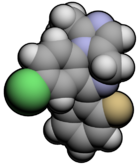Midazolam
 |
|
 |
|
|
Midazolam
|
|
| Systematic (IUPAC) name | |
| 8-chloro-6-(2-fluorophenyl)-1-methyl-4H-imidazo[1,5-a][1,4]benzodiazepine | |
| Identifiers | |
| CAS number | |
| ATC code | N05 |
| PubChem | |
| DrugBank | |
| Chemical data | |
| Formula | C18H13ClFN3 |
| Mol. mass | ? |
| Pharmacokinetic data | |
| Bioavailability | Oral ~36% I.M. 90%+ |
| Metabolism | Hepatic |
| Half life | 1.8-6.4 hours |
| Excretion | Renal |
| Therapeutic considerations | |
| Pregnancy cat. | |
| Legal status |
Schedule IV(US) |
| Routes | Oral, I.M., I.V., parenteral |
Midazolam (marketed under brand names Dormicum, Flormidal, Versed, Hypnovel and Dormonid, pronounced mɪˈdæzəlæm) is a drug which is a benzodiazepine derivative. It has powerful anxiolytic, amnestic, hypnotic, anticonvulsant, skeletal muscle relaxant and sedative properties. It is considered a short-acting benzodiazepine, with a short elimination half-life[1]. It is therefore a very useful drug to use for short minor procedures such as dental extraction.
Midazolam was first synthesized in 1976 by Fryer and Walser.
Contents |
Mechanism of action
Like other benzodiazepines, midazolam acts on the benzodiazepine binding site of GABAA receptors. When bound it enhances the binding of GABA to the GABAA receptor which results in inhibitory effects on the central nervous system.[2]
Indications
Midazolam is indicated for the short term treatment of insomnia in patients who did not adequately react to other (benzodiazepines) hypnotics, and who have persistent trouble in falling asleep. Because of midazolam's extremely short duration, midazolam is not used for patients who have trouble staying asleep through the night; moderate to long acting benzodiazepines like temazepam, nitrazepam, flunitrazepam and lormetazepam are used for those purposes. Like other benzodiazepines, midazolam produces a decrease in delta activity, though the effect of benzodiazepines on delta may not be mediated via benzodiazepine receptors. Delta activity is an indicator of depth of sleep within non-REM sleep; it is thought to reflect sleep quality, with lower levels of delta sleep reflecting poorer sleep. Thus midazolam and other benzodiazepines cause a deterioration in sleep quality. Cyproheptadine may be superior to nitrazepam in the treatment of insomnia as it enhances sleep quality based on EEG studies.[3]
Midazolam is also indicated for the acute management of aggressive or delirious patients and also is sometimes used for the acute management of seizures such as status epilepticus. Long term use for the management of epilepsy is not recommended however, due to the significant risk of tolerance which renders midazolam and other benzodiazepines ineffective and as well the significant side effect of sedation.[4] In mice given chronic midazolam a slowly evolving tolerance developed to the anticonvulsant properties of midazolam over 15 days, although some anticonvulsant effects were still apparent after 15 days of continued administration.[5]
Interactions
Midazolam is metabolized almost completely by cytochrome P450-3A4. Grapefruit juice reduces intestinal 3A4 and results in less metabolism and higher plasma concentrations, which could result in overdose.
Contraindications
Hypersensitivity, acute narrow angle glaucoma, shock, hypotension, head injury, and drug or alcohol use. Most are relative contraindications.
Side effects
Residual 'hangover' effects after nighttime administration of midazolam such as sleepiness, impaired psychomotor and cognitive functions may persist into the next day which may impair the ability of users to drive safely and increase risks of falls and hip fractures.[6]
Pregnancy
Midazolam when taken during the third trimester of pregnancy may cause severe risk to the neonate, including benzodiazepine withdrawal syndrome with possible symptoms including hypotonia, apnoeic spells, cyanosis, and impaired metabolic responses to cold stress. Symptoms of hypotonia and the neonatal benzodiazepine withdrawal syndrome have been reported to persist from hours to months after birth.[7]
Overdose
Symptoms of midazolam overdose include:
- Somnolence (difficulty staying awake)
- Mental confusion
- Hypotension
- Impaired motor functions
- Impaired reflexes
- Impaired coordination
- Impaired balance
- Dizziness
- Coma
- Death
In animal models, the oral LD50 of midazolam is 825 mg/kg.
Midazolam overdose is considered a medical emergency and generally requires the immediate attention of medical personnel. The antidote for an overdose of midazolam (or any other benzodiazepine) is flumazenil (Anexate). The risk of midazolam overdose is increased significantly if midazolam is abused in conjunction with opiates as was highlighted in a review of deaths of users of the opiate buprenorphine in Singapore.[8]
Availability
Dormicum brand midazolam is marketed by Roche as white, oval 7.5mg tablets in boxes of 2 or 3 blisterstrips of 10 tablets, and as blue, oval 15mg tablets in boxes of 2 blisterstrips of 10 tablets. The tablets are imprinted with "Roche" on one side and the dose of the tablet on the other side. Dormicum is also available as 1ml, 3ml and 10ml ampoules at a concentration of 5mg/ml; other manufacturer include Novell Pharmaceutical Laboratories (Miloz) which is available as 3 ml and 5 ml ampoules.
Legal status
In the Netherlands, midazolam is a List II drug of the Opium Law. Midazolam is a Schedule IV drug under the Convention on Psychotropic Substances.[9]
Law enforcement and criminal justice
Midazolam is offered to death row inmates before execution in the United States, according to the 1992 film The Execution Protocol. A Missouri prison doctor interviewed in the film said virtually no prisoners turned down the drug when it was offered a few hours prior to execution.
The drug is also used by trained Paramedics to assist in controlling psychotic or mentally disturbed patients.[10] [11]
Popular culture
Prolonged after-effects of midazolam dosing after dental surgery inspired Duran Duran vocalist Simon Le Bon to entitle the group's 1997 album Medazzaland, likely in reference to psychotropic effects he experienced.
In Saul Bellow's novel Ravelstein, Chick is given Verset (sic) while in hospital after having eaten a red snapper and subsequently poisoned by the ciguatoxin present in the fish.
In the "Til' Death do we part" episode of "The Closer", a dose of Versed slipped into a drink caused the victim to pass out.
In Prison Break, the character Mahone is addicted to Midazolam
See also
- Benzodiazepines
- Triazolam
- Brotizolam
- Estazolam
External links
Notes
- ↑ details of the citation
- ↑ Skerritt JH; Johnston GA. (May 6, 1983). "Enhancement of GABA binding by benzodiazepines and related anxiolytics". Eur J Pharmacol. 89 (3-4): 193–8. doi:. PMID 6135616.
- ↑ Tokunaga S; Takeda Y, Shinomiya K, Hirase M, Kamei C. (February 2007). "Effects of some H1-antagonists on the sleep-wake cycle in sleep-disturbed rats" (pdf). J Pharmacol Sci. 103 (2): 201–6. doi:. PMID 17287588. http://www.jstage.jst.go.jp/article/jphs/103/2/201/_pdf.
- ↑ Isojärvi, JI; Tokola RA. (December 1998). "Benzodiazepines in the treatment of epilepsy in people with intellectual disability". J Intellect Disabil Res. 42 (1): 80–92. PMID 10030438.
- ↑ Garratt JC; Gent JP, Feely M, Haigh JR. (January 5, 1988). "Can benzodiazepines be classified by characterising their anticonvulsant tolerance-inducing potential?". Eur J Pharmacol. 145 (1): 75–80. doi:. PMID 2894998.
- ↑ Vermeeren A. (2004). "Residual effects of hypnotics: epidemiology and clinical implications". CNS Drugs. 18 (5): 297–328. doi:. PMID 15089115.
- ↑ McElhatton PR. (Nov-Dec 1994). "The effects of benzodiazepine use during pregnancy and lactation". Reprod Toxicol. 8 (6): 461–75. doi:. PMID 7881198.
- ↑ Lai, SH; Yao YJ, Lo DS. (October 2006). "A survey of buprenorphine related deaths in Singapore". Forensic Sci Int. 162(1-3): 80–6. doi:. PMID 16879940.
- ↑ List of psychotropic substances under international control
- ↑ Demetria Kalodimos. "I-Team: Injection Used To Subdue Prisoners:Medical Expert Says Practice Is Troubling", WSMV Nashville.
- ↑ Jacob Goldstein. "Taking Sedatives to the Streets", The Wall Street Journal Health Blog.
References
- EMEA Summary of Product Characteristics: Hypnovel and associated names.
- Clinical Use of Midazolam by John Shou.
- Brevoord J, Joosten K, Arts W, van Rooij R, de Hoog M (2005). "Status epilepticus: clinical analysis of a treatment protocol based on midazolam and phenytoin". J Child Neurol 20 (6): 476–81. PMID 15996395.
- Wolfe T, Macfarlane T (2006). "Intranasal midazolam therapy for pediatric status epilepticus". Am J Emerg Med 24 (3): 343–6. doi:. PMID 16635708.
- Johnson T, Rostami-Hodjegan A, Goddard J, Tanner M, Tucker G (2002). "Contribution of midazolam and its 1-hydroxy metabolite to preoperative sedation in children: a pharmacokinetic-pharmacodynamic analysis". Br J Anaesth 89 (3): 428–37. doi:. PMID 12402721. http://bja.oxfordjournals.org/cgi/content/full/89/3/428.
- Prediction of the disposition of midazolam in surgical patients by a physiologically based pharmacokinetic model, Bjorkman, S et al, J Pharm Sci 2001:90(9)1226-1241.
- Merritt P, Hirshman E, Hsu J, Berrigan M (2005). "Metamemory without the memory: are people aware of midazolam-induced amnesia?". Psychopharmacology (Berl) 177 (3): 336–43. doi:. PMID 15290003.
|
||||||||||||||||||||||||||||||||
|
||||||||||||||||||||||||||||||||||||||||||||||||||||||||||||||||||||||||
|
||||||||||||||||||||||||||||||||||||||||||||||||||||||||